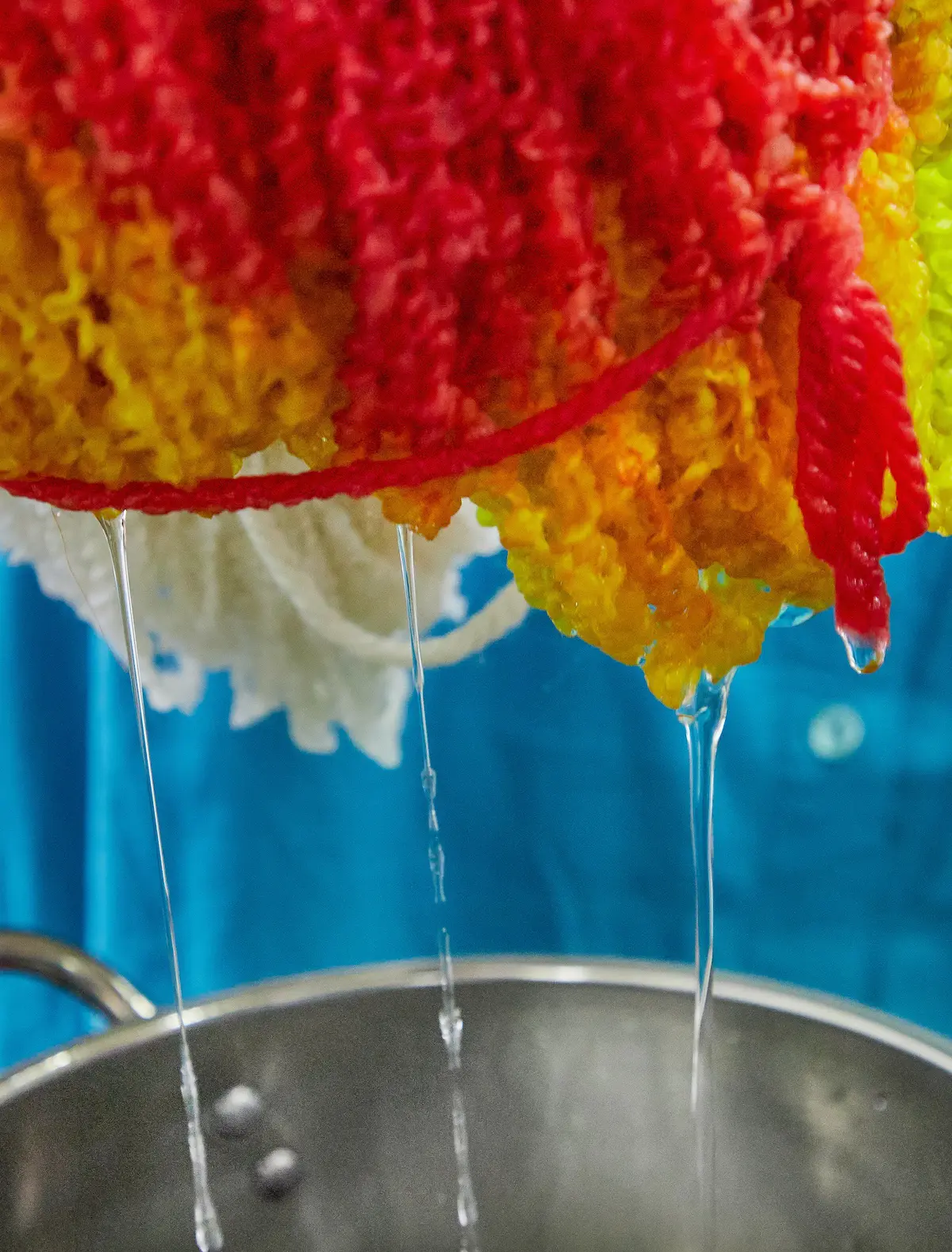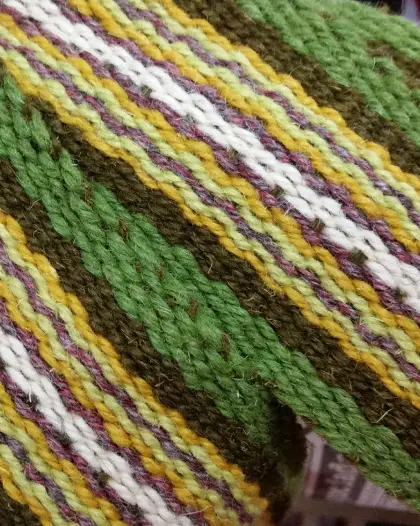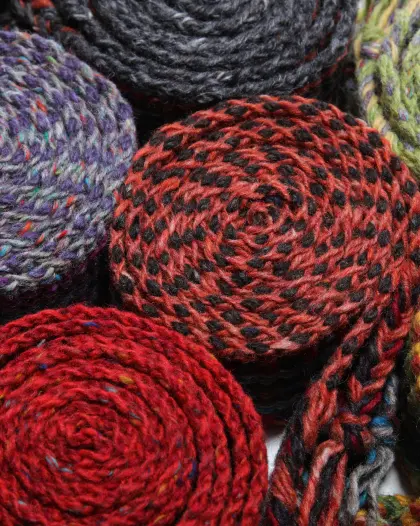Your cart is currently empty!
Our Commitment
to Sustainability
Passionate about sustainability on every level, Liz’s unique approach is exceptional in this age of mass production. Slow fashion accessories consciously and sustainably made – in complete opposition with today’s fast and throwaway fashion – is at our core. Long before it was considered important or topical, our craft business model took a Green approach to the environment. Here, everything is done by hand. Our wooden floor looms are powered by human energy instead of flicking a switch to turn on electricity that drives the looms to weave. Always mindful of the environment, when the Liz Christy signature wool is being dyed, the dye is exhausted from the pot so that water runs clear. As wool is a protein animal-based fibre, acid dyes are used. This natural vinegar-based acid assists in the absorption of the dye from the water into the wool. This water is then reused as a base for the next hank of wool, thus ensuring water is not wasted and only minimal residue is rinsed into their onsite water treatment tank.
Through our Monaghan Local Enterprise Office, we have undertaken to develop and secure our sustainability by embarking on an ESG Certification Programme. This has enabled us to document the Environmental, Social & Governance factors that our business believes to be intrinsically important within current and future business operations and planning. We care deeply about how our products contribute to our sustainable development.
The sustainability journey of Hand-Woven by Liz Chisty was
co-funded by the European Union, under the I-STARS SMP-COSME-2021-TOURSME Project No 101085914. Through this project, we have completed seven training courses to learn and implement best sustainability practices and we will continue to evaluate our business and implement manageable bite sized improvements applied in a LEAN sustainable way.
Acid Dyes and
the Environment
The sustainability of acid dyes can be assessed by examining their environmental impact, degradability, and overall eco-friendliness. Acid dyes are water-soluble and primarily used for protein fibers like wool and silk. Although they require acidic conditions for dyeing, their environmental footprint is minimized through efficient dye uptake and exhaust processes, reducing wastewater pollution and conserving resources.
Advantages of Acid Dyes
-
Degradability
Acid dyes are generally more biodegradable compared to some other classes of dyes, such as heavy metal dyes. This means they break down more easily in the environment, reducing the risk of long-term pollution.
-
Lower Toxicity
Acid dyes typically have lower toxicity compared to heavy metal dyes, which contain metals like chromium and cadmium that can be harmful to both human health and the environment. This makes acid dyes a preferable option from a toxicity standpoint.
-
Efficiency and Performance
Acid dyes are known for their ability to produce vibrant colours and have a good affinity for protein fibres such as wool, silk and nylon. This can lead to less dye being needed to achieve the desired colour, which can reduce the overall environmental footprint of the dyeing process.
-
Reduced Heavy Metal Content
Unlike some fluorescent dyes and heavy metal dyes, acid dyes do not rely on heavy metals to achieve their colours. This eliminates one significant source of environmental contamination.
Environmental Considerations
-
Water Usage
The dyeing process with acid dyes still requires a significant amount of water, and the effluents from dyeing processes can contain residual dyes and chemicals. However, advancements in dyeing technology, such as closed-loop systems and improved wastewater treatment processes, can mitigate some of these issues.
-
Chemical Additives
The dyeing process with acid dyes often involves the use of auxiliary chemicals, such as levelling agents and pH adjusters, which can have their own environmental impacts. The sustainability of acid dyes can be improved by optimising these processes and using more environmentally friendly chemicals. At Liz Christy Studios, we use only vinegar as the acid.
-
Energy Consumption
The dyeing process, including that with acid dyes, typically requires energy, especially for heating the dye baths. Energy consumption can contribute to the carbon footprint of the dyeing process. Implementing energy-efficient practices and utilising renewable energy sources can enhance the sustainability of using acid dyes. At Liz Christy Studios, we use electricity from renewable sources and we are committed to the installation of induction hobs for dye bath heating.
Comparison with Other Dyes
Reactive Dyes
While reactive dyes are often used for cellulosic fibres like cotton, they can form strong covalent bonds with the fibres, leading to less wash-off and better fastness properties. However, they also require substantial water and salt, impacting their sustainability.
Natural Dyes
Natural dyes are considered more environmentally friendly because they are derived from renewable resources and are biodegradable. However, they often require mordants (sometimes containing heavy metals) to fix the dye to the fabric, which can offset their environmental benefits.
Direct and Disperse Dyes
Natural dyes are considered more environmentally friendly because they are derived from renewable resources and are biodegradable. However, they often require mordants (sometimes containing heavy metals) to fix the dye to the fabric, which can offset their environmental benefits.
Conclusion
While acid dyes offer several sustainability advantages over certain other types of dyes, such as heavy metal and fluorescent dyes, they are not without environmental impact. Their relatively good biodegradability, lower toxicity, and efficiency in dyeing processes make them a more sustainable choice within the context of synthetic dyes. However, to maximise their sustainability, it’s important to focus on optimising dyeing processes, improving wastewater treatment, reducing water and energy consumption and using environmentally friendly auxiliary chemicals. At Liz Christy Studios we focus mindfully on all these aspects of our dyeing to continue minimising environmental impact.
Improving Acid
Dye Sustainability
By implementing these improvements, the use of acid dyes can contribute positively to sustainable development in the textile industry, helping to mitigate the negative environmental impact of dyeing processes.







